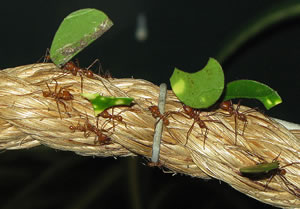Leafcutter ants are the most important insect defoliators of tropical crops.
These ants can reduce vegetable patches to leafless stalks overnight.
Leafcutter ants cultivate crops of fungi, which they nourish with leaves.
A colony of leafcutter ants, with over two million inhabitants, contains different types of individuals.
 A single large queen founds the colony and produces the eggs.
A single large queen founds the colony and produces the eggs.
Next in size are the soldiers, with large, almost triangular heads, and huge shearing mandibles.
The workers vary in size. The largest ones cut leaf pieces from foliage, which they carry back to the nest above their heads. The smaller workers protect the larger ones from parasitic flies, as well as feeding and caring for the larvae.
The pieces of leaf collected by the workers are cut up, chewed to a pulp and used as a substratum for the fungus.
In order for the fungus to decompose leaves, it needs enzymes from fecal secretions of the workers.
Both insects and fungi are therefore necessary for each other's continued survival.
When a leafcutter ant is in distress - perhaps buried in a tunnel or under attack - it scrapes together two specialized structures on its abdomen to make ultrasonic chirps. Other workers detect these chirps as vibrations on the ground. They then come to the aid of their fellow ant.